Social Transformation in Tamil Nadu - Tamil Renaissance | 10th Social Science : History : Chapter 10 : Social Transformation in Tamil Nadu
Chapter: 10th Social Science : History : Chapter 10 : Social Transformation in Tamil Nadu
Tamil Renaissance
Tamil Renaissance
The
cultural hegemony of colonialism and the rise of humanism brought several
changes in the socio-cultural life of the Indian subcontinent. Modern Tamil
Nadu too experienced such a historical transition. Tamil language and culture
played a significant role in their identity construction. The introduction of
printing press, linguistic research on Dravidian languages, etc... underpinned
the process of Tamil renaissance. Although religious literature was taken up
predominantly for publication in the early years after the advent of printing
technology, things began to change gradually. Works that can be described as
secular were taken up for publishing.
Advent of the Printing Technology
Tamil was
the first non-European language that went into print. As early as in 1578,
Tamil book, ThambiranVanakkam, was published from Goa. In 1709, a
full-fledged printing press had been established Ziegenbalg thanks to
Ziegenbalg in Tranquebar. Thirukkural
was one of the earliest Tamil literary texts to be published in 1812. This led
the resurgence of interest among Tamil scholars in publishing the more ancient
Tamil classics around that period.
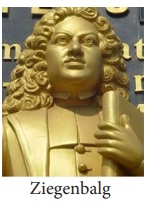
In the
nineteenth century, Tamil scholars like C.W. Damotharanar (1832–1901), and U.V.
Swaminathar (1855–1942) spent their lifetime in the rediscovery of the Tamil
classics. C. W. Damotharanar collected and edited different palm-leaf
manuscripts of the Tamil grammar and literature. His editions included such
texts as Tolkappiyam, Viracholiyam, Iraiyanar-Akapporul,
IlakkanaVilakkam, Kaliththokai and Chulamani. U.V. Swaminathar, a student of Meenakshisundaranar, took
efforts to publish the classical texts such as Civakachinthamani (1887),
Paththupattu (1889), Chilapathikaram
(1892), Purananuru (1894), Purapporul-Venpa-Malai (1895), Manimekalai (1898), Ainkurunuru (1903) and
Pathitrupathu(1904).
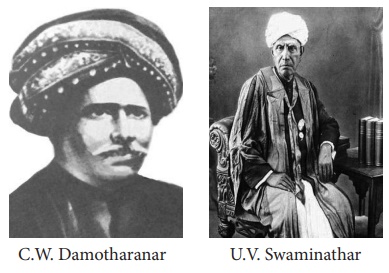
The
publication of these ancient literary texts created an awareness among the
Tamil people about their historical tradition, language, literature and
religion. Modern Tamils founded their social and cultural identity on the
ancient Tamil classics, collectively called the Sangam literature.
In 1816,
F.W. Ellis (1777–1819) who founded the College of Fort St George, formulated
the theory that the south Indian languages belonged to a separate family which
was unrelated to the Indo-Aryan family of languages. Robert Caldwell
(1814–1891) expanded this argument in a book titled, A Comparative Grammar of the
Dravidian or South Indian Family of Languages, in 1856. He established the close affinity between the Dravidian
languages in contrast with Sanskrit and also established the antiquity of
Tamil.
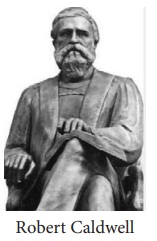
Tamil
intellectuals of this period identified the fundamental differences between
Tamil/Dravidian/ Egalitarian and Sanskrit/ Aryan/Brahmanism. They argued that
Tamil was a language of Dravidian people, who are non-Brahmin and their social
life was casteless, gender-sensitised and egalitarian. Tamil renaissance
contributed to the origin and growth of Dravidian consciousness in the Tamil
country. These ideas are exemplified in the Tamil invocation song in the play, Manonmaniam written by P. Sundaranar
(1855–1897).

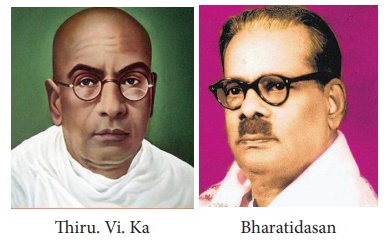
Ramalinga
Adigal (1823–1874), popularly known as Vallalar, questioned the existing Hindu
religious orthodoxy. Abraham Pandithar (1859–1919) gave prominence to Tamil
music and published books on the history of Tamil music. C.W. Damotharanar,
U.V. Swaminathar, Thiru Vi. Kaliyanasundaram (1883–1953), Parithimar Kalaignar
(1870-1903), Maraimalai Adigal (1876–1950), Subramania Bharathi (1882–1921), S.
Vaiyapuri (1891–1956), and the poet Bharatidasan (1891–1964), in their own ways
and through their writings, contributed to the revival of Tamil literature.
Meanwhile, M. Singaravelar (1860–1946) an early pioneer in Buddhist revival,
promoted communism and socialism to counter the colonial power. Pandithar
Iyotheethassar (1845–1914) and Periyar E.V. Ramasamy (1879–1973) held high the
radical philosophy to defend the rights of the socially underprivileged and
marginalised section of the people.
V.G. Suryanarayana Sastri (Parithimar Kalaignar)
V.G.
Suryanarayana Sastri (1870-1903), born near Madurai, was professor of Tamil at
the Madras Christian College. He was one of the earliest scholars to identify
the influence of Sanskrit on Tamil, and adopted a pure Tamil name for himself:
Parithimar Kalaignar. He was the first to argue that Tamil is a classical
language, and demanded that the University of Madras should not call Tamil a
vernacular language. Influenced by Western literary models, he introduced the
sonnet form in Tamil. He also wrote novels and plays, and a number of essays on
science. Tragically, he died at the young age of 33.
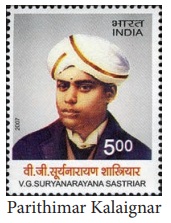
Maraimalai Adigal
Maraimalai
Adigal (1876–1950) is considered the father of Tamil linguistic purism and the
founder of Tani Tamil Iyakkam (Pure Tamil Movement). He wrote commentaries on
the Sangam texts, Pattinappalai and Mullaipattu.

As a
young man, he worked in a journal, Siddhanta Deepika. Later he served as a Tamil
teacher in the Madras Christian College for many years. He was inclined towards
non-Brahmin movement. His teachers such as P. Sundaranar and Somasundara
Nayagar were key influences in his life.
Tani Tamil Iyakkam (Pure Tamil Movement)
Maraimalai
Adigal promoted the use of pure Tamil words and removal of the Sanskrit
influence from the Tamil language. The movement made a great impact on Tamil
culture especially in language and literature. His daughter Neelambikai, played
an important role in its foundation. He changed his own name Vedachalam and
took on the pure Tamil name of Maraimalai Adigal. His journal Jnanasagaram was renamed Arivukkadal and his institution, Samarasa
Sanmarga Sangam, was re-christened as Pothu
Nilai Kalakam. Neelambikai compiled a dictionary that provided pure Tamil
equivalents to Sanskrit words that had crept into Tamil vocabulary.
Related Topics